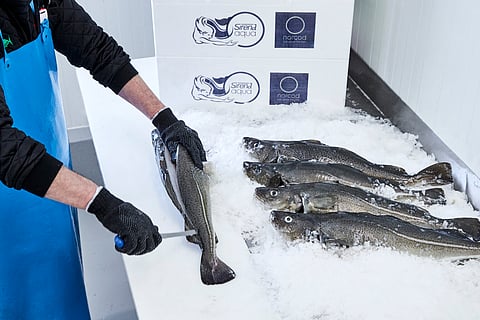

According to the Norwegian Seafood Council data, the export volume of farmed cod increased by 84% in August.
Photo: Norcod.
Norwegian fresh cod followed the same trend in August as in the first six months of the year: due to quota cuts, catches and thus landings of wild cod fell, leading to a decline in export volumes, and while this is happening, farmed cod continues to increase.
Last month, Norway exported 2,341 tonnes of fresh cod worth NOK 143 million (EUR 11.9 million / USD 13.2 million). The value grew by 5% - NOK 7 million (EUR 586 thousand / USD 647 thousand) - compared to the same month 2023, while the volume remained unchanged. Denmark, the Netherlands, and Latvia were the largest markets for Norwegian fresh cod.
August 2024 was also the month trout took over from cod as the second most exported species. In the best August ever for seafood exports in Norway, analysts from the Norwegian Seafood Council (NSC) warned the market trend is uncertain as a lower salmon import price has not been compensated by a corresponding growth in volume, but also because there were lower volumes of both saithe and cod.
For fresh wild cod, both export volume and value have fallen for 11 consecutive months and, as in previous months, the decline in cod quota is the main reason. In August, the export volume of fresh wild cod decreased by 18% to 1,574 tons, while the export value decreased by 12% to NOK 97 million (EUR 8.1 million / USD 8.9 million).
Against these figures, farmed cod is gaining ground: export volume increased by 84% to 767 tons, while export value grew by 72% to NOK 47 million (EUR 3.9 million / USD 4.3 million). So far this year, 8,100 tons of fresh farmed cod have been exported, which is 41% more than last year. Farmed cod accounted for 33% of the value of fresh cod exports in August.
Meanwhile, frozen cod saw China record the highest growth in value terms in August, with an increase of 248% compared to the same month last year, while volume was 109% higher than in August 2023.
"After the US import ban on Russian cod was tightened to include cod processed in third countries, the Chinese processing industry has had to find other suppliers for cod destined for the US market," explained Eivind Hestvik Brækkan, NSC seafood analyst. According to him, it is likely that a large part of the cod imported by China will be processed and re-exported to the US.
If we talk about clipfish, the decline of large cod affected their consumption. Export volume was down 13% to 1,635 tons, while export value was down 7%. The reduced availability of large cod means that small cod are taking a larger share, although large consumers, such as Portugal, are adapting to the change.
"The fact that there are fewer large cod available is a challenge for producers and consumers, who prefer the largest clipfish. So it's positive to see that the Portuguese are adapting to the smaller sizes available and continuing to eat Norwegian clipfish," explained Trond Rismo, envoy to Portugal for the Norwegian Seafood Council.
Finally, in the case of saithe clipfish, the Dominican Republic is Norway's largest market, and also the one with the highest growth in value in August, with an increase in the value of exports of 23% compared to the same month last year.
The export volume to the Dominican Republic closed at 1,800 tons, an increase of 28% over August 2023. Ninety-eight percent of the export volume to the Dominican Republic is saithe clipfish.
